The Han Chinese colonization of Taiwan began at certain points on the west coast, the most famous being Tainan and Lukang. Settlers then moved up waterways to places like Bangka (艋舺, these days known as Wanhua 萬華). However, one of Taiwan’s most characterful old towns isn’t near the sea, nor by a navigable river.
Beipu (北埔) is in the half of Hsinchu County that hasn’t seen much industrialization. The population has been in decline since the early 1980s, and now fewer than 9,400 people live here. Almost all of them are Hakka, yet the name of Beipu’s oldest building is evidence of a multiethnic past.
The single-story, 530-ping Jinguangfu Hall (金廣福公館) was named for the group established in 1835 to organize and defend Han settlers in Beipu and parts of what are now Baoshan (寶山) and Emei (峨眉) townships. Located at 6 Jhongjheng Road (中正路) and recognized as a first-grade relic of national importance, Jinguangfu is open from 9am to 5pm every day. There’s an admission charge of NT$30.
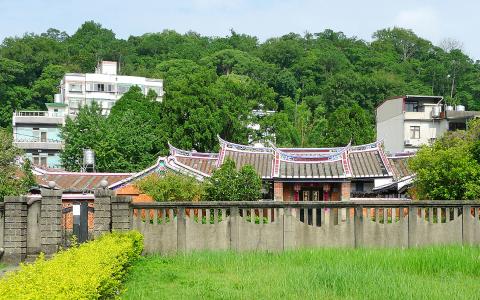
Photo: Steven Crook
The first character (“gold” or “money”) expressed a hope that the pioneers would prosper. The second (an abbreviation for Guangdong, 廣東, province in China) alluded to the Cantonese background of one of the two co-leaders. The third, short for Fujian (福建), was chosen because the other principal was a Hoklo man.
The latter, Lin Te-hsiu (林德修), played no important role after 1836. By contrast, his Hakka counterpart, Chiang Hsiu-luan (姜秀鑾, 1783-1846), retained his position until his death, and his descendants continue to enjoy local prominence.
Before moving to Beipu, Chiang had earned a reputation for organizing effective defenses against indigenous people who objected to having land and natural resources taken from them by Han Chinese migrants. The danger around Beipu was very real. In a single incident in July 1835, Aborigines surrounded and massacred 80 to 90 pioneers. During 1837, more than 40 people were killed by headhunters.
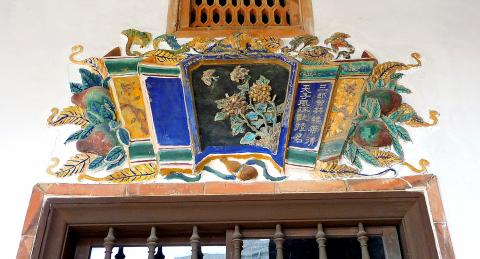
Photo: Steven Crook
In light of this history, it’s odd that one of Jinguangfu’s most intriguing features is neither labelled, nor mentioned in the bilingual leaflet offered to visitors. On either side of the main entrance there are knee-height snipers’ loopholes. It was explained to me that this made it easier for those inside to shoot intruders trying to batter down the door without killing them, thereby avoiding the legal consequences of causing a death. In Qing-era Taiwan, it seems, “stand your ground” laws weren’t quite as householder-friendly as they are in 21st century Florida.
Sporadic violence was a feature of life in Beipu until the early part of the 20th century. One of Chiang Hsiu-luan’s great-grandsons, Chiang Shao-tzu (姜紹祖), apparently committed suicide in the summer of 1895 after an unsuccessful guerilla campaign against the Japanese then taking control of Taiwan.
Another member of the same generation gained a reputation for public-spirited generosity. Chiang Chen-chien (姜振乾) donated money to schools and temples, and to alleviate suffering after natural disasters. He gave clothing and medicine to the poor, and provided wood so those who died penniless wouldn’t lack coffins.
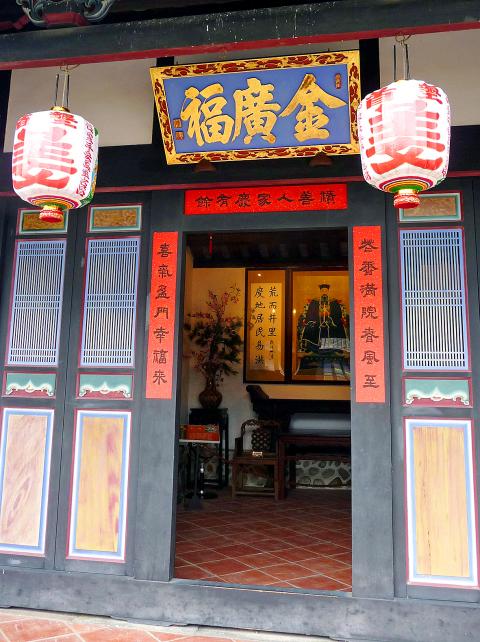
Photo: Steven Crook
More importantly, Chiang Chen-chien intervened in late 1907 when Japanese Army units converged on Beipu, determined to extinguish an uprising that had begun on Nov. 15. On that date, Tsai Ching-lin (蔡清琳) led a band of around 150 Taiwanese to murder 57 Japanese, among them the local postmaster.
During their sweeps through the countryside, Japanese soldiers and police killed dozens of innocent people. Chiang urged the colonial forces to show restraint; to show his sincerity, he offered to cover the forces’ entire expenses during the operation. At the same time, he communicated with local anti-Japanese elements, asking them not to make life more difficult for civilians caught in the middle.
The worst Japanese atrocity occurred in Neidaping (內大坪), where colonial troops killed over 100 people, including the majority of males aged 19 to 79. You’ll pass through the village if you leave Beipu via County Route 37, the route that leads to Beipu Cold Spring (北埔冷泉) and onto Miaoli County.
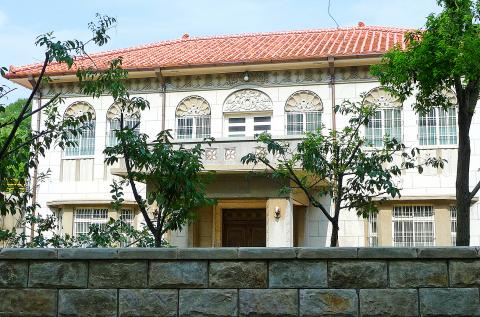
Photo: Steven Crook
At the end of November, Tsai was betrayed by the Saisiyat Aborigines who had joined his uprising. They killed him and delivered his body to the authorities. The rebellion achieved nothing, but after World War II it was celebrated as the first episode of armed Han Chinese resistance to Japanese rule in Taiwan.
During the colonial era, when Beipu boomed thanks to coal and camphor, one member of the Chiang clan founded what later became Hsinchu Bus Company.
Yet another, Chiang A-Hsin (姜阿新), oversaw the building of the two-story mansion which now bears his name at 10 Beipu Street. His tea export business was thriving, so in 1946 he decided to commission the design and construction of a home where his British and Japanese customers would feel comfortable. Renovation work on this landmark is running behind schedule but it should be open to the public before the end of this year.
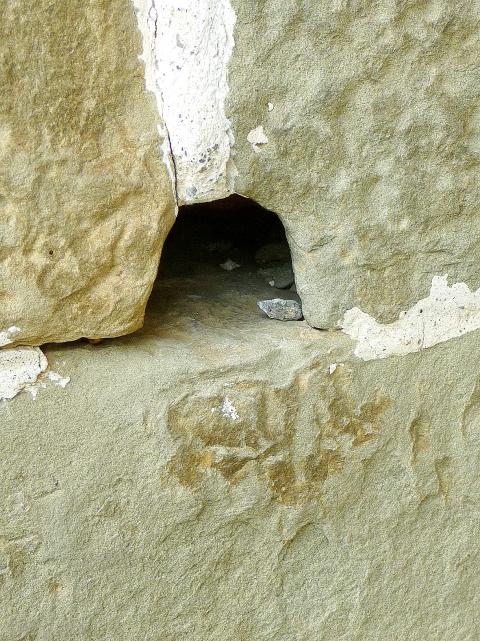
Photo: Steven Crook
Since 2014, the township mayor has been Chiang Liang-ming (姜良明). He’s the fifth person with that family name to hold the office since 1945.
You’ll need a car or a motorcycle to make the most of Beipu’s gorgeous hinterland. But even if you’re depending on buses and unwilling to walk more than a few hundred meters, you’ll find the town itself well worth visiting.
The residence known as Tianshuitang (天水堂) at 1 Jhongjheng Road is over 170 years old and exquisitely traditional. The Chiang branch that owns it has never opened the doors to the public, but if you explore the alleyways around here you can appreciate the exterior from various angles.
Walking south will bring you to the old home of a local scholar. Zhongshu Hall (忠恕堂) at 20 Gongyuan Street (公園街) dates from 1922 and is considered a fine example of Hakka architecture. There’s no admission charge but opening hours are limited (Friday to Sunday, 10am to 11:30am and 1pm to 4:30pm).
Another building falling into the intriguing-yet-off-limits category stands across the road. The permanently-shuttered Deng Nan-guang Photo Memorial (鄧南光影像紀念館) celebrated the life and work of Beipu native Deng (1907-1971).
The photos of daily life he took throughout Taiwan are regarded as an invaluable record of a time before camera ownership became widespread. Anyone with a passion for the past — and if you’ve come to Beipu, you’re probably that kind of person — will hope that one day the memorial can reopen.
Steven Crook has been writing about travel, culture, and business in Taiwan since 1996. Having recently co-authored A Culinary History of Taipei: Beyond Pork and Ponlai, he is now updating Taiwan: The Bradt Travel Guide.

Oct. 21 to Oct. 27 Sanbanqiao Cemetery (三板橋) was once reserved for prominent Japanese residents of Taipei, including former governor-general Motojiro Akashi, who died in Japan in 1919 but requested to be buried in Taiwan. Akashi may have reconsidered his decision if he had known that by the 1980s, his grave had been overrun by the city’s largest illegal settlement, which contained more than 1,000 households and a bustling market with around 170 stalls. Fans of Taiwan New Cinema would recognize the slum, as it was featured in several of director Wan Jen’s (萬仁) films about Taipei’s disadvantaged, including The Sandwich

“Wish You Luck is not just a culinary experience, it’s a continuation of our cultural tradition,” says James Vuong (王豪豐), owner of the Daan District (大安) Hong Kong diner. On every corner of Kowloon, diners pack shoulder-to-shoulder over strong brews of Hong-Kong-style milk tea, chowing down on French Toast and Cantonese noodles. Hong Kong’s ubiquitous diner-style teahouses, known as chachaanteng (茶餐廳), have been a cultural staple of the city since the 1950s. “They play an essential role in the daily lives of Hongkongers,” says Vuong. Wish You Luck (祝您行運) offers that same vibrant melting pot of culture and cuisine. In

Much noise has been made lately on X (Twitter), where posters both famed and not have contended that Taiwan is stupid for eliminating nuclear power, which, the comments imply, is necessary to provide the nation with power in the event of a blockade. This widely circulated claim, typically made by nuclear power proponents, is rank nonsense. In 2021, Ian Easton, an expert on Taiwan’s defenses and the plans of the People’s Liberation Army (PLA) to break them, discussed the targeting of nuclear power plants in wartime (“Ian Easton On Taiwan: Are Taiwan’s nuclear plants safe from Beijing?”, April 12, 2021). The

Artificial intelligence could help reduce some of the most contentious culture war divisions through a mediation process, researchers say. Experts say a system that can create group statements that reflect majority and minority views is able to help people find common ground. Chris Summerfield, a co-author of the research from the University of Oxford, who worked at Google DeepMind at the time the study was conducted, said the AI tool could have multiple purposes. “What I would like to see it used for is to give political leaders ... a better sense of what people ... really think,” he said, noting surveys gave